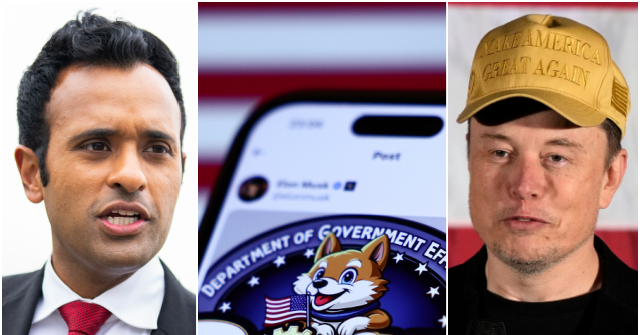Donald Trump is moving fast, and yet the Swamp Empire is striking back.
The President-elect has asked two key supporters, Elon Musk and Vivek Ramaswamy, to lead the Department of Government Efficiency or DOGE. Their mission: Cut federal spending by $2 trillion.
In response, defenders of the status quo are ready to repel. The Washington Post snipes that Musk would “apply slash-and-burn business ideologies to the U.S. government.” The Hill ran a headline stating that “Musk’s bold plans for ‘Department of Government Efficiency’ face roadblocks,” which quoted four D.C. experts saying it couldn’t—or shouldn’t—be done. Other publications call DOGE a “joke,” and “dumb and dangerous.”

Elon Musk’s post about DOGE on X is displayed on an iPhone. (Jakub Porzycki/NurPhoto via Getty Images)
On the airwaves, MSNBC’s Alex Wagner and George Conway chuckled that DOGE is a “fantasy football league.”
In fact, post-war history is riddled with well-intended bodies that sought to shrink, or at least streamline, the federal government, including the Hoover Commission, the Ash Council, the Grace Commission, Gramm-Rudman, Reinventing Government, and Simpson-Bowles. Some had some successes, but a look at the steady upward trendline of federal spending shows the results were nothing like what DOGE has in mind.
On the other hand, Trump is a proven master at moving the Overton Window. Moreover, polls show Americans have an exceedingly dim view of the federal government.
In addition, DOGE has the wind of technological transformation at its back. Venture capitalist Marc Andreessen is circulating a graphic showing the prices for some goods falling; for instance, over the last quarter-century, a television is 98 percent cheaper. “The primary mission of technology and economy policy,” says Andreessen, “should be to put everything on the TV price curve.”
To be sure, TVs and other digital tech have benefited from the quantum leaps of Moore’s Law, which applies to electrons, not to people and their politics.
Yet Musk has proven he can cost-crash on a broad canvas. For example, over the last 15 years, SpaceX has reduced the cost of lifting a kilogram of cargo into orbit by 90 percent. And just in the past two years, Musk reduced the head-count of Twitter, now X, by almost 90 percent, even as the site has grown and improved.
With plenty of justification, Musk can tweet to critics of DOGE, “Threat to democracy? Nope, threat to BUREAUCRACY!!!”
Yet naysayers will point out that even if every bureaucrat in Washington were fired, DOGE would still not come close to its $2 trillion target. Why? Because the big bucks are in income-transfer programs, including Social Security, Medicare, Medicaid, and oh yes, payments on the national debt—which accounts for about 10 percent of the budget. Defense spending is about 13 percent.
In all, the feds spend nearly $7 trillion a year, and yes, there’s plenty of waste, fraud and abuse (here’s looking at you, Covid money). Yet history suggests that much of Congress will oppose cutting one program or another, because, ill-gotten or not, it’s money for constituents back home.
Inside and outside the Beltway, these oppositions have a way of overlapping and synergizing; so it’s possible that all spending programs survive.
Such multi-echelon resistance explains why President Ronald Reagan failed to eliminate such obvious targets as the National Endowment for the Arts, National Public Radio, and the Department of Education—he simply didn’t have the votes in Congress.
Indeed, even greater societal forces prop up spending. One such is Baumol’s Cost Disease, which explains that labor-intensive organizations cost more and evermore, because they can’t be automated. Schools are one example, the military is another. Yes, perhaps AI and robots could replace teachers and soldiers, but are we ready for that? Do we have such trust in the machines, and whoever programs them?
Another deep force is Wagner’s Law, which holds that over time, as countries industrialize and people move to cities, governments simply get bigger. Folks on the farm can likely feed themselves if they have to, but not urbanites. Ministers in marble palaces might not care if the yokels in the boondocks are restive, but if a mob gathers outside their office window, they have to care—and so money gets spent, both to police and to placate.
Taking these two rules together, we are reminded that for anything the government does, there’s a constituency that is organized, well-wired, and lobbied-up.
These factors don’t make the DOGE cause hopeless; they make it hard. So, for most of the cuts DOGE seeks, it will have to identify a replacement model; that is, a better way to accomplish the goal. For instance, if we abolish the Department of Education—and with to make the abolition stick—we must show that local solutions, including school choice, can actually educate children better.
Furthermore, if DOGE looks to the supply-side—to economic growth and abundance—it will find plenty of sugar to make the oftentimes bitter medicine of spending cuts go down better.
Notably, Trump has suggested using “liquid gold,” that is, the oil beneath our feet. We can add, too, the “vapor gold” of natural gas and the “solid gold” of coal. If we add all those carbon fuels together, we reach a value, according to the Institute For Energy Research, that can be measured in the quadrillions of dollars.
(This carbon energy can, of course, be cleaned up and carbon-captured; indeed, byproducts are the basis for a carbon-circular economy, spawning new industries of plastics and nanotubes.)
If these humongous wealth figures are unfamiliar to most Americans, that’s because the MMSM (Malthusian Main Stream Media) has been conspiring with Big Green to hide the truth about our God-given plenty.
For his part, always dismissive of small thinking, Trump nails it when he says America can enjoy profound ENERGY DOMINANCE–those were Trump’s capitalizations when he announced North Dakota Gov. Doug Burgum to be his Interior Secretary and energy czar–if we are willing to drill and dig. So DOGE can zero out spending on “green energy,” including the last-minute $145 billion that the Biden-Harris administration wishes to give to its friends.
As an aside, it’s not just oil we have lots of: It’s everything, including rare earths; the more we look, the more we find. Indeed, the deepest mine we’ve ever dug goes down just 2.5 miles; for comparison, it’s 1800 miles to the earth’s core–so there’s lots of room to go deeper. In the most literal sense, we’ve only scratched the surface; there’s vastly more prospecting, discovering, and digging to be done.
Such wealth opens up new ways of thinking about shrinking the federal government, while still keeping faith with popular goals.
Here’s one way: We can move whole categories of spending off the federal ledger by letting them be financed by a new off-budget natural-resource trust fund.
For instance, Uncle Sam spends $1 trillion a year on Medicare. The program is so popular that it’s deemed to be mostly untouchable; and in fact, there’s nothing wrong with helping seniors stay healthy.
Could Medicare, which accounts for 15 percent of annual expenditures, be tightened up? Sure. But as they say, one man’s waste is another man’s job—and a senior’s health care. So, there’ll be a struggle over every nickel. It’s good to fight the good fight, and yet it’s also good to be realistic about what’s possible and popular.
So, if we can’t cut much of Medicare, we can at least move it. That is, move the program off the national budget, to be directly financed by natural treasures, just as the University of Texas is supported by oil revenues.
A dedicated fund for Medicare would be a win-win-win: A win for senior health, a win for tax reduction, and a win for natural-resource production, as producers would now have the senior citizens’ voter bloc solidly on their side.
With such creative thinking, DOGE hits its target, as MAGA makes another advance.



